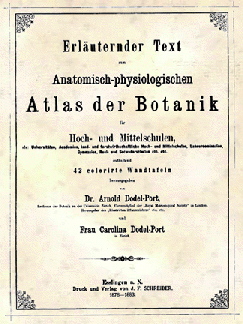Botanical Atlas
by Arnold & Carolina Dodel-Port, Switzerland
42 charts 1878-1883
This beautifully illustrated series on plant systematics was created by Dr Arnold Dodel-Port of the University of Zurich, and his wife Carolina. Of the original 42 charts, the University Museum Collections currently hold 38.


Left: 2 - SCHIZOMYCETES
This shows a mixture of tiny single-celled organisms. Our understanding of micro- organisms has grown enormously over the past century, and those shown here would now be separated into bacteria and fungi.
Right: detail from 4 - VOLVOX GLOBATOR L.
This shows the freshwater green alga Volvox globator. Many individual cells live together forming a beautiful spherical colony. Some of them are specialized for reproduction.


Left: 30 - CUSCUTA GLOMERATA
The chart illustrates the way in which a plant parasite, Dodder, derives nutrients from a host plant such as flax or hops. In the past Dodder was responsible for considerable loss of yield from these crops. The plant has no connection with the ground and no roots and green pigment of its own. The large central diagram shows how, with protuberances from its stem, it is able to penetrate the tissues of its host, thereby "stealing" a supply of nutrients and water.
Right: 38 - CYDONIA VULGARIS
Illustrations of the flower and fruit of the quince Cydonia vulgaris. Here the flower is shown being pollinated by a bee. Quince was popular as a fruit in Britain from the 13th century, and was particularly common in the 16th - 18th centuries when it was often used to make quince marmalade.
A complete set of digitised images of the Dodel-Port Atlas can be seen on the Memory of the Netherlands website.
